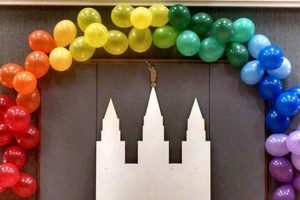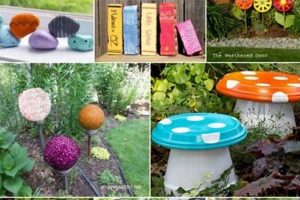Creating personalized adornments for the annual celebration of love through do-it-yourself methods offers a cost-effective and emotionally resonant approach to festive embellishment. For example, hand-crafted paper hearts, repurposed materials transformed into themed banners, or bespoke floral arrangements fall under this category.
The significance of engaging in such creative endeavors lies in the ability to infuse personal style and sentiment into the celebratory atmosphere. Benefits include the potential for significant cost savings compared to commercially produced items, the fostering of creativity, and the creation of unique and memorable displays. Historically, handcrafting decorations has been a widespread practice, allowing individuals to express their affections through tangible creations.
The subsequent sections will explore specific project ideas, material sourcing strategies, and design considerations to facilitate the creation of memorable and personalized expressions of affection for the designated occasion.
Tips for Handcrafted Valentine’s Day Adornments
Achieving professional-looking results when creating homemade Valentine’s Day ornamentation requires careful planning and execution. The following tips offer guidance for optimizing the aesthetic appeal and longevity of hand-crafted items.
Tip 1: Material Selection: Opt for high-quality materials appropriate for the intended application. For paper-based projects, acid-free cardstock provides durability and prevents yellowing over time. Consider the longevity of chosen adhesives; archival-quality glue sticks or double-sided tapes prevent discoloration and ensure secure bonding.
Tip 2: Precise Measurement and Cutting: Accuracy in measurement and cutting is paramount. A sharp craft knife, cutting mat, and ruler are essential tools for achieving clean lines and symmetrical shapes. Employ templates when creating multiple identical elements to maintain consistency.
Tip 3: Color Palette Coordination: Select a cohesive color palette to create a unified aesthetic. Limiting the number of colors and varying their shades and tones prevents a visually cluttered appearance. Consider the psychological impact of color choices; reds and pinks evoke passion, while softer hues convey tenderness.
Tip 4: Layering and Dimension: Incorporating layers and dimensional elements adds visual interest. Utilize foam squares or dimensional glue to elevate certain components, creating depth and shadow. Experiment with overlapping shapes and textures to introduce complexity.
Tip 5: Securing Suspension: When hanging decorations, employ secure and discreet hanging mechanisms. Clear fishing line or thin wire provides a nearly invisible suspension system. Reinforce attachment points with additional adhesive to prevent detachment.
Tip 6: Incorporate Natural Elements: Introduce natural elements, such as dried flowers, twigs, or foliage, to enhance the visual appeal and add an organic touch. Ensure that any natural materials are properly dried and treated to prevent decay or pest infestation.
Tip 7: Protect Finished Pieces: Apply a sealant or protective coating to fragile creations, especially those exposed to humidity or handling. A light coat of clear varnish or acrylic spray can provide added durability and prevent damage.
Adhering to these guidelines contributes to the creation of visually pleasing and structurally sound decorative elements for the Valentine’s Day celebration. Attention to detail and careful execution elevate homemade items to a level of sophistication comparable to commercially produced alternatives.
The concluding section will address storage and preservation techniques to ensure the longevity of handcrafted decorations for future use.
1. Material Selection
Material selection constitutes a foundational element in the realm of do-it-yourself Valentine’s Day decorations. The choice of materials directly impacts the aesthetic appeal, structural integrity, and overall longevity of the finished product. An example illustrates this: utilizing tissue paper for a banner results in a fragile, easily torn decoration, unsuitable for prolonged display. Conversely, employing cardstock offers greater durability, rendering the banner more resistant to wear and tear. Therefore, the consequences of inappropriate material selection can manifest as aesthetically displeasing and functionally deficient decorations.
The importance of informed material choices extends beyond simple durability. The chosen materials influence the perceived value and sophistication of the decorations. For instance, incorporating natural elements, such as dried flowers or polished stones, can elevate the design, conveying a sense of elegance and thoughtfulness. Conversely, reliance on inexpensive, mass-produced materials might detract from the overall impact, projecting an image of cost-cutting rather than heartfelt sentiment. Furthermore, consider the environmental impact; opting for recycled or sustainable materials aligns with environmentally conscious values.
Effective material selection requires a careful evaluation of project requirements and desired outcomes. Understanding the properties of different materials, considering their aesthetic qualities, and assessing their environmental impact are crucial steps. Addressing potential challenges, such as material availability and cost, is essential for project feasibility. Consequently, thoughtful material selection is not merely a preliminary step but an integral aspect that significantly determines the success of do-it-yourself Valentine’s Day decorations.
2. Tool Proficiency
Proficiency in the use of various tools constitutes a critical determinant of the quality and efficiency of do-it-yourself Valentine’s Day decorations. The level of skill in handling these implements directly impacts the precision, uniformity, and overall aesthetic appeal of the finished decorative elements.
- Cutting Implements: Precision and Safety
Proficient use of cutting implements, such as craft knives, scissors, and cutting machines, is paramount for achieving clean lines and intricate shapes. Skillful handling minimizes errors and material waste, ensuring accurate execution of design patterns. Safety considerations are equally important; proper technique reduces the risk of injury and enhances the overall crafting experience. For example, a steady hand and controlled pressure are crucial when using a craft knife to cut out delicate paper snowflakes or heart shapes.
- Adhesive Applicators: Bonding Strength and Appearance
Effective application of adhesives, whether using glue guns, glue sticks, or double-sided tape, requires precision and control. The goal is to create strong, inconspicuous bonds that do not detract from the appearance of the decoration. Over-application of glue can result in unsightly residue and compromise the aesthetic integrity of the project, while insufficient adhesive may lead to structural failure. Selecting the appropriate adhesive type for the materials being used is also essential; for example, hot glue is suitable for bonding heavier elements, whereas glue sticks are better suited for paper-based projects.
- Measuring and Marking Tools: Accuracy and Consistency
Accurate measurements and markings are fundamental for ensuring uniformity and symmetry in decorative elements. Proficiency in using rulers, templates, and marking tools contributes to a polished and professional appearance. Inconsistent measurements can lead to misaligned components and a visually unappealing final product. For example, precise measurements are necessary when creating a symmetrical heart garland or accurately spacing letters in a banner.
- Painting and Finishing Tools: Aesthetics and Durability
Skillful use of painting and finishing tools, such as paintbrushes, spray paints, and varnishes, enhances the aesthetic appeal and durability of decorations. Even application techniques prevent streaks and uneven color distribution, contributing to a professional-looking finish. Protective coatings, such as varnishes, can safeguard decorations from moisture and UV damage, extending their lifespan. For example, a properly applied coat of sealant can protect hand-painted wooden hearts from fading or chipping.
The integration of tool proficiency into the crafting process is not merely a matter of technical skill; it directly translates to the quality and longevity of do-it-yourself Valentine’s Day decorations. Mastering the proper use of these tools enables the creation of aesthetically pleasing and structurally sound decorative elements, enriching the celebratory atmosphere.
3. Design Principles
The application of fundamental design principles is paramount in elevating do-it-yourself Valentine’s Day decorations from amateur creations to aesthetically pleasing and visually coherent expressions of affection. These principles provide a framework for organizing visual elements, ensuring harmonious and impactful decorations.
- Balance: Visual Equilibrium
Balance, in design, refers to the distribution of visual weight within a composition. It can be symmetrical, asymmetrical, or radial. In the context of decorations, a balanced arrangement of elements ensures visual stability and prevents a cluttered or chaotic appearance. For example, a symmetrically arranged banner with equally sized and spaced hearts on either side of a central point demonstrates visual balance. Asymmetrical balance might involve arranging decorations of varying sizes and shapes, compensating for their visual weight to achieve equilibrium. A failure to consider balance can result in a design that feels lopsided or unbalanced.
- Proportion: Scaled Harmony
Proportion deals with the relative size and scale of different elements within a design. Harmonious proportions create visual appeal, while disproportionate elements can appear jarring or awkward. For instance, when creating a Valentine’s Day centerpiece, the size of the floral arrangement should be proportional to the size of the vase and the surrounding table space. Similarly, the scale of individual components within the floral arrangement, such as the size of the flowers relative to the greenery, should be carefully considered. Neglecting proportion can lead to decorations that appear visually disharmonious or out of place.
- Color Harmony: Unified Aesthetics
Color harmony involves the selection and arrangement of colors to create a unified and pleasing aesthetic. A well-considered color palette enhances the emotional impact of the decorations and contributes to a cohesive visual theme. Color harmonies can be based on analogous colors (adjacent on the color wheel), complementary colors (opposite on the color wheel), or monochromatic schemes (variations of a single color). For example, a color palette based on shades of pink, red, and white creates a classic and romantic Valentine’s Day atmosphere. In contrast, a haphazard mix of clashing colors can result in a visually jarring and unappealing display.
- Emphasis: Focal Point Creation
Emphasis is the principle of creating a focal point within a design, drawing the viewer’s attention to a specific element or area. A focal point can be achieved through various techniques, such as contrast, color, size, or placement. For example, a large, intricately designed heart placed prominently in the center of a mantel display serves as a clear focal point. Alternatively, a brightly colored element surrounded by more subdued tones can create emphasis. Without a clear focal point, a design can feel visually monotonous and lack impact.
In conclusion, the deliberate application of design principles significantly enhances the visual impact and aesthetic appeal of handcrafted Valentine’s Day decorations. By carefully considering balance, proportion, color harmony, and emphasis, individuals can create visually cohesive and emotionally resonant decorations that effectively convey sentiments of affection and celebration. Attention to these principles elevates the quality of do-it-yourself projects, transforming them into thoughtfully designed expressions of love.
4. Technique mastery
Technique mastery forms a crucial link in the successful execution of Valentine’s Day decorations projects. The level of expertise in specific crafting techniques directly impacts the aesthetic quality, durability, and overall visual impact of homemade embellishments. A lack of proficiency in relevant techniques can lead to poorly executed designs, material wastage, and ultimately, unsatisfactory decorative outcomes. Conversely, mastery of skills such as paper quilling, calligraphy, or advanced cutting techniques allows for the creation of intricate and professional-looking decorations. For example, skillful paper quilling can transform simple strips of paper into elaborate heart designs, while competent calligraphy adds a personalized and elegant touch to banners and cards. The mastery of these techniques, therefore, directly translates into the ability to produce higher-quality and more visually appealing Valentine’s Day decorations.
The practical significance of technique mastery extends beyond mere aesthetics. Accurate cutting techniques, for instance, ensure that decorative elements fit together seamlessly, contributing to the structural integrity of the finished product. Proper adhesion techniques prevent decorations from falling apart or becoming damaged during display. Furthermore, understanding the nuances of different painting and finishing techniques allows for the creation of durable and visually appealing surfaces that resist wear and tear. Consider the application of decoupage: mastering the technique of applying layers of paper and sealant ensures a smooth, durable finish, preventing bubbling and peeling. These practical applications underscore the importance of acquiring and refining relevant crafting skills for successful and long-lasting Valentine’s Day decorations.
In summary, technique mastery represents a fundamental component of successful DIY Valentine’s Day decoration projects. Acquiring and refining relevant skills not only enhances the aesthetic quality of the finished product but also contributes to its durability and longevity. While challenges such as time constraints and the initial learning curve may exist, the investment in technique mastery yields significant returns in the form of personalized, professional-looking decorations that effectively convey sentiments of affection and celebration. This element strongly supports the overall goal of creating memorable and meaningful Valentine’s Day experiences.
5. Project management
Effective project management serves as a critical framework for the successful execution of do-it-yourself Valentine’s Day decorations. Without strategic planning and resource allocation, the creation of elaborate decorations can quickly become overwhelming, leading to missed deadlines and compromised results. Project management provides a structured approach to ensure timely completion and optimal utilization of resources.
- Scope Definition
The scope definition stage involves clearly outlining the project’s objectives, deliverables, and boundaries. In the context of creating Valentine’s Day decorations, this includes determining the types and quantities of decorations to be made, identifying target locations for display, and setting specific aesthetic goals. An example involves specifying the creation of five paper heart garlands, one fabric banner, and a centerpiece arrangement, defining the scope prevents scope creep and ensures that efforts are focused on achieving clearly defined objectives.
- Time Management
Time management entails the creation of a realistic timeline for completing each task, from material sourcing to final assembly. This involves breaking down the overall project into smaller, manageable steps and allocating specific timeframes for each. For example, allocating two hours for material shopping, three hours for cutting and assembling paper hearts, and one hour for banner construction. Effective time management prevents last-minute rushes and ensures that decorations are completed well in advance of the celebration.
- Resource Allocation
Resource allocation involves identifying and assigning the necessary resources, including materials, tools, and human labor, to each task. This includes creating a budget for material purchases, ensuring that all necessary tools are available, and delegating tasks to individuals with the appropriate skills. For example, assigning one person to source materials while another focuses on design development. Proper resource allocation minimizes bottlenecks and ensures that all required components are readily available.
- Risk Management
Risk management involves identifying potential challenges that could impede project progress and developing mitigation strategies. This includes anticipating material shortages, addressing potential skill gaps, and planning for unforeseen delays. For example, having backup materials on hand in case of damage or wastage, or identifying alternative design options in case a specific technique proves too difficult. Proactive risk management minimizes disruptions and ensures that the project stays on track despite unforeseen circumstances.
By effectively implementing project management principles, individuals can significantly enhance the efficiency and success of their do-it-yourself Valentine’s Day decorations endeavors. These structured approaches enable the creation of aesthetically pleasing and visually coherent expressions of affection, transforming what could be a chaotic process into a streamlined and enjoyable experience. The result is a more personalized and meaningful celebration of Valentine’s Day.
Frequently Asked Questions Regarding Valentine’s Day Decorations DIY
This section addresses common inquiries pertaining to the creation of personalized adornments for the Valentine’s Day celebration through do-it-yourself methods. The aim is to provide clarity and guidance on practical considerations for successful implementation.
Question 1: What constitutes the primary advantage of opting for DIY Valentine’s Day decorations as opposed to commercially manufactured alternatives?
The principal benefit lies in the capacity to personalize the decorations to reflect individual tastes and sentiments, fostering a unique and emotionally resonant celebratory atmosphere. Cost savings and creative expression also represent significant advantages.
Question 2: What are the most common pitfalls encountered when embarking on DIY Valentine’s Day decoration projects?
Frequently encountered challenges include inadequate planning, insufficient material selection, lack of tool proficiency, and failure to adhere to fundamental design principles. Poor time management also contributes to project setbacks.
Question 3: What material choices are most appropriate for creating durable and visually appealing Valentine’s Day decorations?
High-quality cardstock, durable fabrics (such as felt or canvas), and resilient adhesives are recommended. Natural elements like dried flowers and polished stones enhance visual appeal while sustainably sourced or recycled materials promote environmental consciousness.
Question 4: What is the most effective method for preventing color fading or degradation in handmade Valentine’s Day decorations exposed to sunlight?
Application of a UV-resistant sealant or protective coating is advised. Selecting materials with inherent UV resistance, such as fade-resistant paints and fabrics, is also beneficial. Limiting prolonged direct sunlight exposure extends the lifespan of the decorations.
Question 5: What strategies can be employed to enhance the longevity and preservability of handcrafted Valentine’s Day decorations for future use?
Proper storage in airtight containers away from direct sunlight and moisture is crucial. Delicate items should be individually wrapped in acid-free tissue paper to prevent damage. Consider employing desiccants to absorb excess moisture during storage.
Question 6: What basic tools are essential for undertaking a wide range of DIY Valentine’s Day decoration projects?
Essential tools include a craft knife, scissors, cutting mat, ruler, glue gun, glue sticks, assorted paintbrushes, and a selection of measuring and marking implements. A cutting machine (such as a Cricut or Silhouette) can significantly enhance efficiency for intricate designs.
These FAQs provide a foundational understanding for individuals considering engaging in do-it-yourself Valentine’s Day decorations. Careful planning and execution are crucial for achieving successful and satisfying results.
The succeeding section will present a comprehensive guide to material sourcing and cost-effective strategies for acquiring necessary supplies.
Conclusion
The preceding sections have explored the multifaceted aspects of Valentine’s Day decorations DIY, encompassing material selection, tool proficiency, design principles, technique mastery, and project management. A comprehensive understanding and application of these elements are critical for creating personalized and aesthetically pleasing embellishments for the annual celebration of affection. The significance of meticulous planning, precise execution, and thoughtful design choices has been consistently emphasized.
As individuals embark on crafting their own Valentine’s Day decorations DIY, a commitment to quality, creativity, and attention to detail will yield rewarding results. The benefits of these efforts extend beyond mere cost savings, encompassing the expression of personal sentiment and the creation of enduring memories. The ongoing pursuit of improved techniques and design innovation will undoubtedly continue to enrich the realm of homemade decorations, providing unique and meaningful ways to commemorate the occasion.







